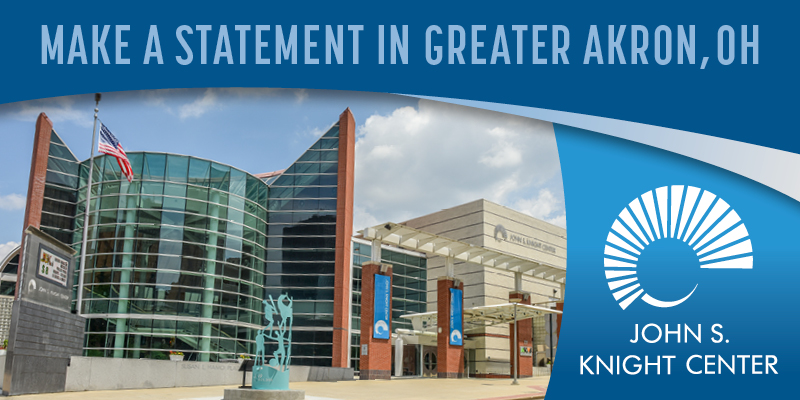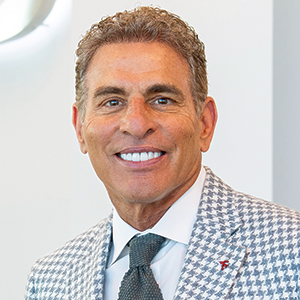Some aviators may argue that Flexjet’s ultra-modern fleet of nearly 300 luxury aircraft is key to the company’s exponential growth. Others credit its team, including more than 1,100 experienced pilots who bring twice the industry’s average flight hours to the cockpits. But chairman Kenn Ricci knows that culture is the glue that holds these key components together, contributing to Flexjet’s leading position in the private aviation industry.
“Culture is the most important thing,” he says, sitting in his office overlooking Flexjet’s tarmac from the company’s sleek new global headquarters at Cuyahoga County Airport. “I always say that culture eats strategy for breakfast. It’s not taught; it’s absorbed, and that requires a huge amount of leadership.”
As Flexjet expands around the globe, with more than 4,000 employees serving 30 locations worldwide, Ricci’s top priority is ensuring that the company’s service-focused culture continues to saturate each interaction. By embracing three guiding principles — a long-term approach to relationships, a fanatical attention to detail and a steadfast belief that employees are the foundation of a service company — Ricci fuels Flexjet’s growth while carving out its position as an industry leader.
ADVERTISEMENT
Taking flight
After starting his aviation career as an Air Force Reserve Officer Training Corps (ROTC) cadet at the University of Notre Dame, Ricci began to establish and invest in a range of aviation-focused enterprises. In 1998, he founded Flight Options with the innovative idea of selling fractional shares of pre-owned aircraft to compete with other companies that were selling shares of brand-new planes. This model allowed clients to buy a portion of a jet, gaining access to private air travel without the full cost and responsibilities of whole-aircraft ownership.
Under Ricci’s leadership, Flight Options achieved $100 million in sales within the first five months, advancing to $300 million within two years. By 2001, the company had grown to more than 200 aircraft and 1,500 employees, including nearly 1,000 pilots. This rapid growth captured the attention of larger fractional programs — resulting in a merger, and eventual buy-out, from Raytheon Travel Air. But by 2008, Raytheon had nearly run the company into the ground and decided to sell it back.
“It was in a much worse position,” Ricci says. “It was losing about $30 million a year. The planes hadn’t been updated. A lot of the customers had gone away. The pilots had unionized. And then the financial crisis hit.”
Recovery took several years, but by 2011, Ricci had stabilized the business and restored profitability. Knowing he needed to upgrade his fleet, he approached Bombardier, the world’s largest aviation manufacturer, to buy more aircraft. However, Bombardier owned a competing fractional jet ownership division called Flexjet. Rather than selling aircraft to a competitor, they offered to sell him the company, knowing he’d buy more jets from them than they’d buy from themselves.
Ricci merged Flexjet and Flight Options in 2013, dissolving the “tarnished brand” of Flight Options while retaining Flexjet’s strong presence in the market. Then, he placed the largest order in Flexjet’s history for 245 Bombardier jets, valued at more than $5 billion. After that, Flexjet began expanding its fleet beyond Bombardier, adding jets from Embraer and Gulfstream with the goal of offering exquisitely luxurious private travel experiences.
“If you can’t define your unique competitive advantage and build a strategy around it, you don’t have a recipe for success,” Ricci says. “We decided our unique competitive advantage is being upscale.”
Seeking freedom from the union
For several years after acquiring Flexjet, Ricci worked to free the company from the grips of the pilot union — a bold move that would distinguish Flexjet from the industry’s status quo.
“Displacing a pilot union has never been done; in fact, to not have a pilot union is very uncommon,” Ricci explains. “Without making the effort to get rid of the union, we would’ve had a difficult time doing the things we do today that make us special.”
Getting rid of the union required breaking the union contract he inherited when he acquired the company. These legal hurdles were worth the risk, though, because Ricci simply wanted the best for his employees. He wanted his pilots to feel a sense of pride and ownership in the company’s mission, without union intervention.
“The reason people organize as a union is because they need an empathetic peer group to belong to, and you replace that group by building trust,” he says. “To win the hearts and minds of employees, they have to believe in your honesty. It has to be genuine. If you have the ulterior motive of just trying to lower your cost structure, you’re not going to be successful.”
Ricci gradually earned the trust of his team, who voted to forgo union participation. That enabled the launch of Flexjet’s premium Red Label program, which features flight crews dedicated to a single aircraft. Flexjet’s Red Label aircraft comprise the most modern fleet in the industry, each less than five years old, with artisan interiors that look lavish compared to the competitor’s standard beige designs.
This dedicated crew model provides an unmatched level of personalized service and pride that distinguish Flexjet from the rest of the industry — complete with a Red Label Academy where cabin servers are trained to deliver high-end, five-star service.
“Unlike the airlines, we don’t have a cockpit door or a gate agent; our customer service rep is our pilot,” Ricci says. “If the pilot isn’t the frontline customer service of the company, we can’t deliver the luxury service that we want to deliver. That’s what the union had eliminated, and that’s what I wanted to get back.”
Putting people first
Even beyond the Red Label program, Flexjet’s dedication to its people sets the company apart. From its hiring practices to its day-to-day culture, the company embraces its guiding principle that “employees are the foundation of the company.”
Flexjet sets the bar high for its employees, and expects dedication in return. For example, the standard hiring criteria for most pilots is about 1,500 flight hours, but Flexjet has a hiring minimum of 3,000.
“The average pilot we’re hiring is about five or six years later in their career,” says Ricci, who has logged more than 6,000 hours of flight, including extensive international experience. “Our starting salary is also 50 percent higher than our competitors for an entry-level pilot, so we’re hiring people who want this to be a career destination.”
To make sure they’re hiring pilots with the right personality, Flexjet regularly conducts psychological profiles of its hundred best performing pilots, then screens candidates against that profile.
“Our best pilots have a social part of their personality,” Ricci says, “where, as you can imagine, social interaction is not part of the military qualification for pilots. Without the cabin door, social interaction is really important.”
Once employees are hired, Ricci says the worst thing a company can do is stifle their enthusiasm with a handbook full of rules. To that end, Flexjet is designing a new HR wing on its campus with a relaxed setting to expose new employees to the company culture. It will look “like a club,” he says, “with couches, barstools and booths” in place of generic offices, because “the campus has to reflect the ideas we’re trying to create.”
To gauge how well teammates are living up to Flexjet’s expectations, every year on the anniversary of their hire, employees receive a thank you card in the mail along with a self-evaluation based on the company’s three fundamental principles. Open-ended questions like, “How did you pay fanatical attention to detail?” and “How did you create long-term relationships?” reinforce these values while encouraging employees to provide honest feedback about their job satisfaction and career goals.
“Empathy is the most important habit that leaders can have,” Ricci says. “You cannot be a leader if you can’t convince people that they can trust you to help them achieve what they want.”
Expanding across the globe
Staying ahead of travel trends has been key to Flexjet’s growth. For example, about 15 years ago, Ricci realized that international travel required a patchwork of flight plans. Customers might take a private jet to New York, board a first-class flight to London, and then arrange another private jet to their final destination. Taking a nonstop private flight overseas seemed like a cost-prohibitive hassle, even for upscale clientele.
“We decided that, if we were going to be a premium brand, we had to offer services to premier locations,” Ricci says. “So, while it wasn’t a big market, we had to have an international fleet.”
Around 2018, Flexjet began acquiring larger, international-capable aircraft as it expanded into Europe. In 2019, the company opened a European headquarters, a European Tactical Control Center to coordinate flight logistics and a European aircraft maintenance facility.
Previously, Flexjet’s prime service area stretched from Hawaii to the Virgin Islands, spanning about 5,500 nautical miles. For efficiency, aircraft would stay where they landed until a customer booked a flight back.
“Once customers here started going to Europe, we had to expand the prime service area to Europe,” Ricci says. “We needed customers in Europe who wanted to come this way, so we had to start marketing in the European market.”
Flexjet’s prime service area extended from London to Dubai, about 3,000 nautical miles, to offer connections back to North America. Now, that area is expanding again.
“We’re seeing a tremendous amount of transport in and out of the Middle East,” Ricci says, “so this year, we have to open up the market in the Middle East.”
Today, Flexjet logs about 15 transatlantic flights per day, up from only 15 per month about five years ago. Flexjet’s international-capable fleet now comprises 60 aircraft, accounting for nearly 20 percent of its entire fleet.
Anchoring future growth
Flexjet’s third guiding principle — fanatical attention to detail — is obvious when visiting the company’s new global headquarters that opened in Cleveland’s Cuyahoga County Airport in 2023.
“The primary vision was to create a place that our employees would brag about, so we wanted a cool space, number one,” Ricci says. “Number two, we knew that our clients would come here, so we wanted to make a good first impression on customers, too.”
The centerpiece of the new 51,453-square-foot facility is the Global Operations Control Center, a futuristic space dominated by a massive LED screen, measuring about 176 feet wide by 20 feet high — making it the largest in the U.S. and the third largest in the world. The screen displays tracking data for every Flexjet flight, providing a centralized, real-time view of global operations for staff, who are arranged in tiered stadium-style seating around the screen.
The control center is strategically situated so that visitors see the glowing LED screen through the glass-walled building as soon as they step off the plane, creating an impressive sales tool for prospective clients. Even the architectural details of the building were strategically designed — not only does the star-shaped, glass-encased façade look sleek and upscale, the angular overhangs also provide protection for planes to taxi underneath while shielding visitors from rain and snow.
The $50 million facility was designed to accommodate future growth. Although the building currently houses about 670 of the 4,000 employees who work for Flexjet and its sister companies around the world, it has the potential to support the staff and technology required to manage twice the current fleet, with additional renovations planned throughout the campus.
“We anticipate this will be an anchor for a long time,” Ricci says.
Since revenue and employee numbers are typically more visible on paper than in person, the expansive new HQ provides a tangible testament to how much the company has grown.
“Seldom do you get something so reflective of 25 years of growth,” says Ricci, who received a Lifetime Aviation Entrepreneur Award in 2016 and was inducted as a Living Legend of Aviation three years later. “I got a tear in my eye coming in here, seeing the physical representation of what we’ve achieved. I have a lot of pride in what we’ve been able to do.” ●
TAKEAWAYS:
- Build trust and empathy with employees.
- Foster a culture that puts people first.
- Stay ahead of emerging trends.
- Create a cool workspace to accommodate growth.



